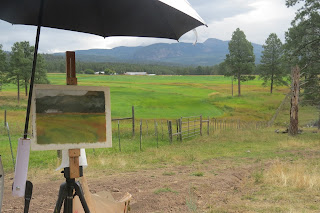plein air oil 9" x 12"
click here for Paypal
$295.00 + $10. s/h
As I often do when looking for a painting title I use Google. So, I googled "hay". I ended up on farm collector.com (which I have to admit I didn't know existed) and learned all of this:
From Farm Collector.com:
Today, petroleum-based products are essential to farm operations. But for thousands of years, fodder – specifically, hay – was the most critical form of fuel on the farm. Up to the late 18th century, the process of making hay remained essentially unchanged. By the 1850s, though, the impact of the Industrial Revolution on farming equipment history was unmistakable.
In this article, the first segment of a three-part series on hay equipment (see Part 2 and Part 3), the focus is on mowers. Farmers who still cut hay with sickles or scythes well into the mid-1800s were quick to embrace new technology. One of the most labor-intensive chores a farmer faced, the harvest and storage of hay was hard, hot and dusty work. Mowers were the first step toward making that job less brutal and more productive.
References to cutting and drying grass for fodder are found as far back as Biblical times. Up to the late 18th century, though, the process of manual mowing remained essentially unchanged.
A difficult evolution
Robert L. Ardrey compiled the history of companies and inventors who played key roles in the history of American agriculture in his 1894 book American Agricultural Implements. Ardrey acknowledged that early mower inventors had a difficult time moving away from their attempts to imitate the cutting motion involved in the manual harvest of hay.
“It was this natural primitive movement that the first constructors of both reapers and mowers tried to imitate or reproduce in their machines,” Ardrey wrote. “Early American inventors of mowers persistently endeavored to make practically operative this original principle. Indeed, it was many years before the rotary or scythe-curve theory of cutting was abandoned.”
Peter Gaillard, Lancaster, Pa., is credited with conceiving the idea of mowing grass with horse power in 1812. Several crude reaping machines were produced prior to that time in England, but none proved practical enough to come into general use. In his research, Ardrey found that the early interchangeable use of the words “mow” and “reap” had already made it difficult to clearly identify the origin of the earliest mowers.
“As reapers and mowers belong to the same original general class – harvesters – and have so many features in common,” Ardrey wrote, “it is somewhat difficult at times to draw the line between them. In many of the older patents they are described as machines for reaping and mowing, having been designed for both purposes. And in some specifications they are described first as one and then as the other without distinction of purpose. So one cannot always clearly understand to which division of the general class the inventor intended his machine, or to which it really belonged.”
Jeremiah Bailey, Chester County, Pa., patented a mower (or grass-cutting machine) in February 1822. It was supported by two wheels on different axles and was said capable of mowing 10 acres per day. John Wadsworth, Portsmouth, R.I., obtained a patent in 1824 for a horse scythe. A year later, in 1825, Ezra Cope and Thomas Hoopes Jr., both also of Chester County, applied for a patent on a mowing machine similar to Bailey’s. Their machine was more simply constructed and said to be “of better form.”














